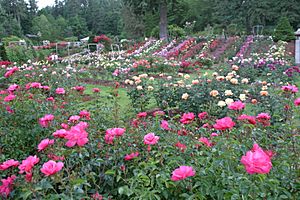Olmsted Portland park plan facts for kids

Imagine a city filled with beautiful parks, tree-lined streets, and walking paths. That's what a special plan, created in 1903, aimed to do for Portland, Oregon. This plan was made by the famous Olmsted Brothers firm, who were experts in designing outdoor spaces. Their ideas helped shape how Portland grew, adding many parks, pretty roads, and walking trails.
The city's new Park Board, which was an early version of today's Portland Parks & Recreation, asked the Olmsted Brothers for help. A board member named Thomas Lamb Eliot guided this project. The plan was a big part of the "City Beautiful movement," which was a popular idea at the time to make cities more attractive and organized. This important report was shared on December 31, 1903. It came out just before Portland hosted a big event, the 1905 Lewis and Clark Centennial Exposition.
Creating Portland's Green Spaces
The Olmsted Brothers' plan was a guide for Portland's future. It showed where to put new parks and how to connect them with scenic roads. This helped make Portland a greener and more enjoyable place to live.
Who Were the Olmsted Brothers?
The Olmsted Brothers were a very famous landscape architecture firm. This means they were experts at designing outdoor areas like parks, gardens, and even entire city layouts. They created many well-known parks across the United States. Their work in Portland was one of their many important projects.
Making the Plan Happen
In 1908, a person named Emanuel Tillman Mische was hired to help make the plan a reality. He used to work for the Olmsted Brothers. Mische became the Parks Superintendent for Portland and worked on the plan until 1914.
However, it was not always easy to put the plan into action. The city needed to buy land for the new parks, but land prices started to go up very quickly. In 1909, John Olmsted, one of the brothers, even said that "Portland is not awake to her opportunities." This meant he felt the city wasn't moving fast enough to buy the land it needed.
Despite these challenges, the Olmsted plan has been very important over the years. It has guided most of the development of Portland's parks. Many of the green spaces you see in Portland today are there because of this original plan from 1903.

